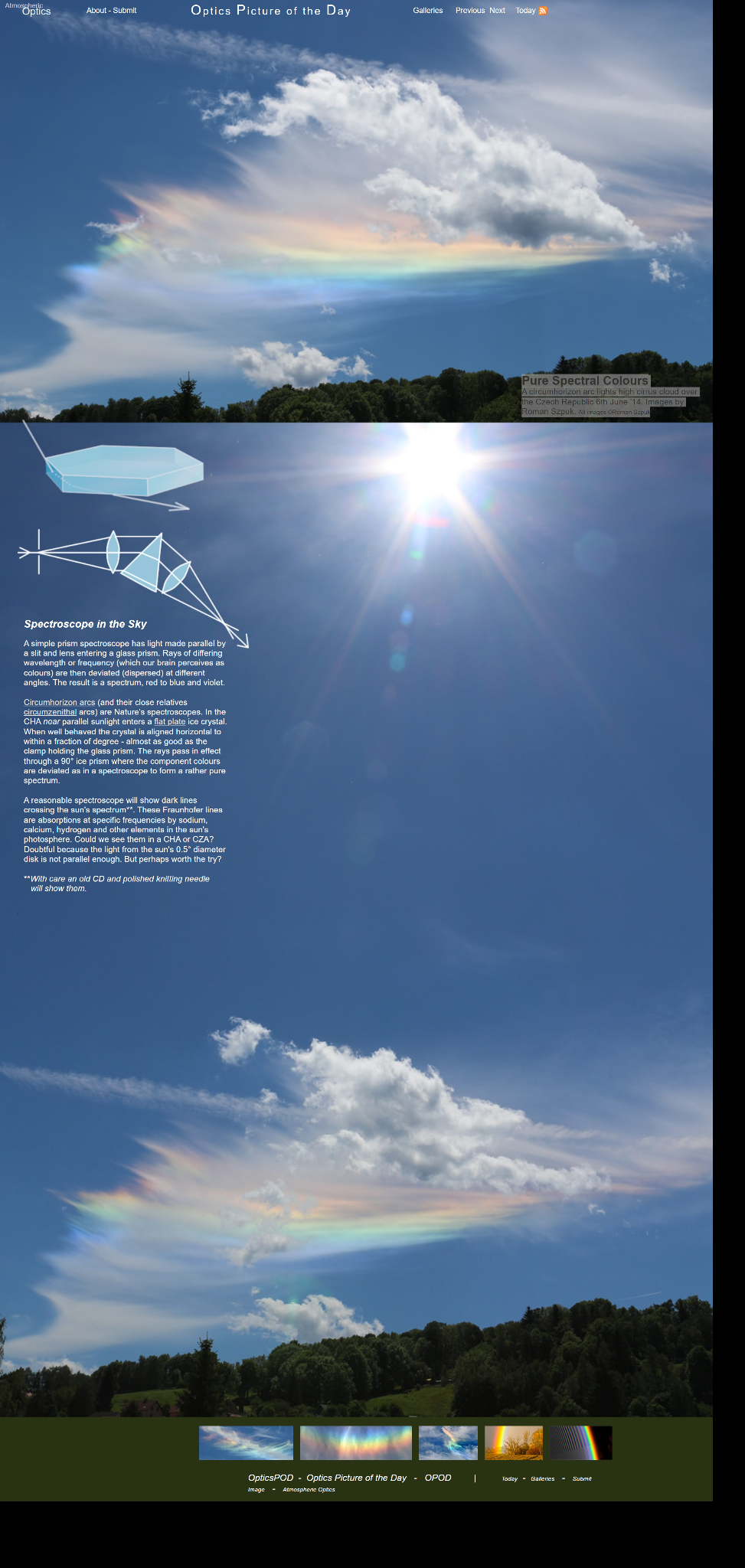Czech Circumhorizon Arc - OPOD
Czech Circumhorizon Arc - OPOD: A Spectacular Atmospheric Phenomenon
Have you ever witnessed a stunning display of pure spectral colors illuminating the sky? One such mesmerizing phenomenon is the Czech Circumhorizon Arc (CHA). On June 6th, 2014, Roman Szpuk captured breathtaking images of this celestial spectacle over the Czech Republic. In this article, we will delve into the intricacies of the CHA, exploring its formation, characteristics, and the fascinating similarities it shares with a prism spectroscope.
Understanding the Spectroscope in the Sky
To comprehend the magic behind the CHA, let's first familiarize ourselves with a simple prism spectroscope. This ingenious device employs a glass prism to disperse light into its component colors. By passing parallel light through a slit and lens, the prism refracts the different wavelengths or frequencies, creating a spectrum ranging from red to blue and violet. The human brain perceives these variations in color as distinct hues.
The CHA: Nature's Spectroscope
Nature has its own version of a spectroscope in the form of circumhorizon arcs (CHA) and their close relatives, circumzenithal arcs (CZA). In the case of CHAs, sunlight enters flat plate ice crystals at a near-parallel angle. When these crystals align almost perfectly horizontally, they act as prisms, dispersing the sunlight into a remarkably pure spectrum.
Similar to the spectroscope's dark lines that represent absorptions by specific elements in the sun's photosphere, the CHA also exhibits potential absorptions. These absorptions, known as Fraunhofer lines, occur at specific frequencies due to elements like sodium, calcium, and hydrogen present in the sun. However, observing these lines within a CHA or CZA is challenging since the sunlight's angle is not parallel enough. Nevertheless, it might be worth attempting to detect them.
Unveiling the Fraunhofer Lines
While it may seem improbable, with some care and ingenuity, it is indeed possible to catch a glimpse of the Fraunhofer lines within a CHA or CZA. Surprisingly, everyday objects like an old compact disc (CD) and a polished knitting needle can be employed to reveal these spectral lines. By carefully aligning the CD and focusing sunlight through the needle onto the disc, you might just witness these absorptions.
Intriguingly, the Czech Circumhorizon Arc provides a captivating opportunity to observe the natural world imitating the principles of a spectroscope. The delicate alignment of ice crystals in the atmosphere mimics the behavior of a glass prism, dispersing sunlight into a mesmerizing spectrum. While the Fraunhofer lines may remain elusive within a CHA or CZA due to the non-parallel nature of sunlight, the possibility of their observation adds an element of curiosity to this already awe-inspiring phenomenon.
In Conclusion
The Czech Circumhorizon Arc (CHA) is a breathtaking atmospheric optics phenomenon that graces the skies with its display of pure spectral colors. By understanding the concept of a spectroscope, we can appreciate the remarkable resemblance between the CHA and this scientific device. While the chance to observe Fraunhofer lines within a CHA or its close relative, the circumzenithal arc (CZA), may be slim, the allure of attempting to uncover these absorptions adds an element of intrigue to this natural spectacle. So, keep your eyes on the sky and be prepared to witness the beauty of the Czech Circumhorizon Arc, a true testament to the wonders of our atmosphere.

Pure Spectral Colours
A circumhorizon arc lights high cirrus cloud over the Czech Republic 6th June '14. Images by Roman Szpuk. All images ©Roman Szpuk

Spectroscope in the Sky
A simple prism spectroscope has light made parallel by a slit and lens entering a glass prism. Rays of differing wavelength or frequency (which our brain perceives as colours) are then deviated (dispersed) at different angles. The result is a spectrum, red to blue and violet.
Circumhorizon arcs (and their close relatives circumzenithal arcs) are Nature's spectroscopes. In the CHA near parallel sunlight enters a flat plate ice crystal. When well behaved the crystal is aligned horizontal to within a fraction of degree - almost as good as the clamp holding the glass prism. The rays pass in effect through a 90° ice prism where the component colours are deviated as in a spectroscope to form a rather pure spectrum.
A reasonable spectroscope will show dark lines crossing the sun's spectrum... These Fraunhofer lines are absorptions at specific frequencies by sodium, calcium, hydrogen and other elements in the sun's photosphere. Could we see them in a CHA or CZA? Doubtful because the light from the sun's 0.5° diameter disk is not parallel enough. But perhaps worth the try?
..With care an old CD and polished knitting needle
will show them.
Note: this article has been automatically converted from the old site and may not appear as intended. You can find the original article here.
Reference Atmospheric Optics
If you use any of the definitions, information, or data presented on Atmospheric Optics, please copy the link or reference below to properly credit us as the reference source. Thank you!
-
<a href="https://atoptics.co.uk/blog/czech-circumhorizon-arc-opod/">Czech Circumhorizon Arc - OPOD</a>
-
"Czech Circumhorizon Arc - OPOD". Atmospheric Optics. Accessed on November 26, 2024. https://atoptics.co.uk/blog/czech-circumhorizon-arc-opod/.
-
"Czech Circumhorizon Arc - OPOD". Atmospheric Optics, https://atoptics.co.uk/blog/czech-circumhorizon-arc-opod/. Accessed 26 November, 2024
-
Czech Circumhorizon Arc - OPOD. Atmospheric Optics. Retrieved from https://atoptics.co.uk/blog/czech-circumhorizon-arc-opod/.